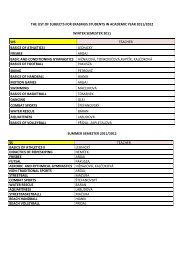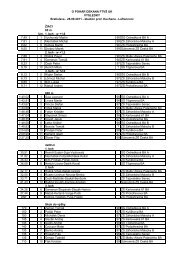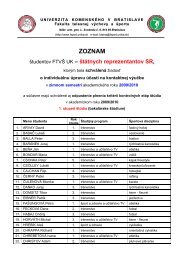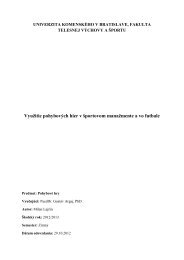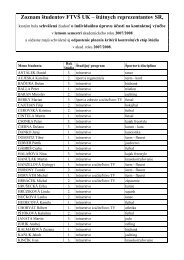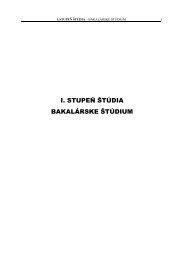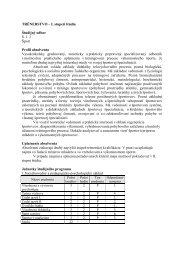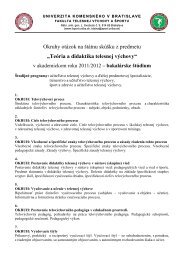acta facultatis educationis physicae universitatis comenianae
acta facultatis educationis physicae universitatis comenianae
acta facultatis educationis physicae universitatis comenianae
You also want an ePaper? Increase the reach of your titles
YUMPU automatically turns print PDFs into web optimized ePapers that Google loves.
Differences in game performance parameters of winning and losing ice-hockey teams<br />
37<br />
Discussion<br />
In comparison to other sports games, there still exist only few works dealing with parameters<br />
of match effectiveness of an ice-hockey team, or with differences in game performance<br />
parameters of winning and losing teams. Our results indicate that the importance of certain<br />
parameters of effectiveness is generally applicable and does not disappear with the trends of<br />
the ice hockey development. We clarified even the meaning of man-to-man fights and puck<br />
carrying.<br />
By means of comparison of selected game performance parameters between the winning<br />
and losing teams, we ascertained significant differences. As expected, they were manifested<br />
in parameters of shooting and saves, considered the final game skills. Teams that are more<br />
successful were not only more effective in shooting, but also more active in shooting attempts.<br />
According to our findings, they shot nearly two-times more per period and their shooting<br />
effectiveness was in most cases of 12 % higher than in losing teams, which would not be a<br />
significant difference if the shooting effectiveness of losing teams was not mostly 0 %. This<br />
is perhaps the fact that does not change in spite of various developmental tendencies in ice<br />
hockey because Bukač et al. at the 1978 World Championships drew similar conclusions<br />
also. That is why we may state that it is highly probable that one of the conditions of a team’s<br />
success in a match is both a higher quality and quantity of shooting. As regards the parameters<br />
of saves, the winning team goaltenders analogously faced fewer shots and frequently<br />
finished a period without a goal in their net. Naturally, the goaltender’s performance reflects<br />
also the defensive game of the whole team, however, based on our results and in concordance<br />
with Bukač et al. (1980), we may state that the result of a match is highly affected by the<br />
goaltender’s performance.<br />
The importance of power play was not confirmed clearly. At 2010 Olympics, the winning<br />
teams profited from power play. However, the question was not the number and duration of<br />
power plays. Those factors were not significantly different from those of the losing teams.<br />
Crucial was the shooting success and power play effectiveness. The winning teams scored<br />
in power play mostly one-time per period and made use of one of three power plays, while<br />
the power play effectiveness in the losing teams was zero. It is interesting that nearly identical<br />
values were found more than 30 years ago also by Kostka, Bukač, Dovalil (1979). It also<br />
appears that not the number and duration of penalty kills are crucial, but the number of goals<br />
scored against and penalty kill effectiveness, i.e. defence of the whole team and effectiveness<br />
of saves.<br />
Significant importance in invasive games has been attributed to solution to situations<br />
1v1, the so-called man-to-man fights. It appears that they can be crucial from the aspect of<br />
the result, in particular when resolved in front of the own or opponent’s cage or basket, and<br />
that an effective solutions to man-to-man fights are even more important than solutions to<br />
other kinds of game situations (such as 1v2, 2v2, etc.) (Andrejkovič, 2008). Our research,<br />
focused specifically on situations 1v1, confirmed this statement. It confirmed the differences<br />
namely in effectiveness of solutions to situations 1v1 in offence and in relation to individual<br />
zones of the rink during offence in the attacking zone. The aim of each team is to spend<br />
a considerable part of the game in the attacking zone. A team, able to carry the puck, combine<br />
at a small space, assert in man-to-man situations in the attacking zone, is also able to create<br />
goal opportunities and thus to build up its success in a match. The finding that no difference<br />
between the winning and losing teams was found in effectiveness of solutions to situations<br />
Acta Facultatis Educationis Physicae Universitatis Comenianae LII/I



